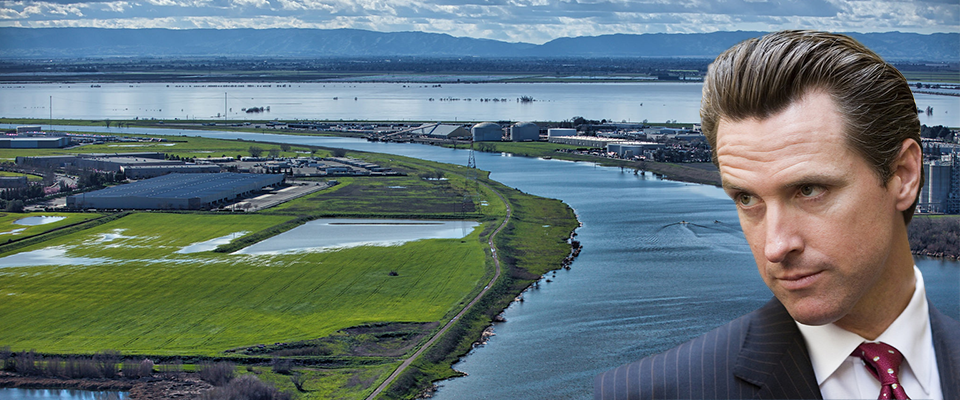The extravagantly wet winter notwithstanding, California’s water woes are far from over. But recent moves suggest Governor Gavin Newsom is leading the state into a new era of water policy. Last month, he decided to scale back his predecessor’s decades-long effort, the Twin Tunnels, to deliver water from Northern to Southern California.
“Really, the idea that two massive tunnels would be built in the Delta was always—well, a pipe dream,” says Peter Gleick.
This massive project, known as the California WaterFix, was promoted by Jerry Brown as the solution to the state’s agricultural and urban water insecurity and environmental degradation in the Sacramento/San Joaquin Delta. Conceived as two 35-mile-long, 40-foot-diameter pipes buried under the Delta, the Twin Tunnels would’ve incorporated a great deal of concrete, steel, and machinery to move tremendous quantities of water southward. (Read more about Brown’s water plan here.)
Ultimately, though, it was a bridge—or tunnel—too far, even for Brown. And UC Berkeley water experts generally agree Newsom’s move away from the WaterFix is a pragmatic one.
“Jerry really wanted that legacy project, but he overplayed his hand,” says Richard Walker, a Berkeley professor emeritus of geography who has written extensively on state infrastructure, water, and agricultural issues. “The WaterFix was clearly a relic of the past. It doesn’t accord with either the will of the people of California or the actual way that state water management is moving.”
“Really, the idea that two massive tunnels would be built in the Delta was always—well, a pipe dream,” says Peter Gleick, a UC Berkeley alum and the president emeritus of the Pacific Institute, a water-oriented think tank. “It was always clear that you could get far better results spending much less money by exploring other avenues.”
And that’s exactly what experts anticipate Newsom will do. By scaling back Brown’s all-encompassing megaproject, he appears to be moving towards what analysts call a “portfolio” approach—or multiple, integrated programs, including one smaller tunnel.
Newsom’s support of a single-tunnel project hardly constitutes a comprehensive state water policy, say pundits. But it does confirm the two dramatically different views Newsom and Brown hold on water—differences certain to be highlighted in the upcoming policies of the new administration.
“The WaterFix was clearly a relic of the past. It doesn’t accord with either the will of the people of California or the actual way that state water management is moving.”
“I’ve been talking to folks in Sacramento, and no one really has any grasp on the details,” says Berkeley alum Barry Nelson, a water policy consultant and a former senior policy analyst focused on the Bay-Delta estuary for the Natural Resources Defense Council. Still, Nelson says, Newsom’s move seems to indicate strong support for a portfolio approach to water management.
“Brown’s approach was the single solution—the tunnels,” says Nelson. “But [many environmentalists] have always felt that a portfolio solution was preferable. That means multiple components, including a single tunnel with sharply defined capacity and limits, strong Delta protections, conservation, water recycling, stormwater capture, flood plain restoration, and aquifer recharge. You just end up with a more efficient, flexible system that way, and for much less cost.”
Under a new distributed system, water storage and distribution is controlled by multiple stakeholders, rather than just the State of California and the federal government calling all the shots. The feds and the state remain players, of course, but more power goes to the regional and local agencies. In fact, ambitious wastewater recycling and stormwater capture projects already are underway in Southern California.
“For example, the Inland Empire Utilities Agency in Southern California is developing a program funded by a state water bond [Proposition 1] that recycles wastewater and stores it in the Chino Groundwater Basin,” says Nelson.
That recycled water is then distributed to the Metropolitan Water District of Southern California (MET), a regional agency which supplies water to urban water agencies and around 19 million people. MET uses the recycled water as a replacement for Delta water, which remains stored in Lake Oroville, where it can be released to provide through-Delta flows during dry years when juvenile salmon need extra water to make it safely out to sea.
“It’s an extremely elegant solution to both urban water needs and Delta environmental issues,” says Nelson.
Newsom’s support of a single-tunnel project hardly constitutes a comprehensive state water policy. But it does confirm his dramatically different views on water.
Walker sees another way the demise of the Twin Tunnels could benefit the environment.
Much of the cropland in the western San Joaquin Valley is tainted with toxic selenium, says Walker. When these soils are irrigated, the selenium leaches out into the San Joaquin River and the Delta, killing fish and wildlife. As part of a new portfolio approach, these lands could be converted to unirrigated pasturage for livestock, saving millions of acre-feet of water and eliminating a major source of water pollution.
“We’re not talking about the destruction of San Joaquin Valley agriculture,” says Walker. “We’re talking about the sensible shrinkage of irrigation on impaired lands.”
Still, Newsom’s new policies may not translate as an environmental boon. But water historically flows toward money in the West, and there are no guarantees that any extra will actually benefit the Delta.
“If we’re going to really fix the Delta, we need to convert [a significant portion of any] water savings into reductions in Delta diversions,” says Peter Gleick. “We have to acknowledge the evidence that a big part of the Delta’s problem is the amount of water we’re taking out. That was the fatal flaw of the Twin Tunnels—there was never a limit on the amount of water that could be shipped. It’s one thing to save water and use it to restore the Delta. It’s another to use it to expand irrigated croplands and put in more subdivisions.”


















